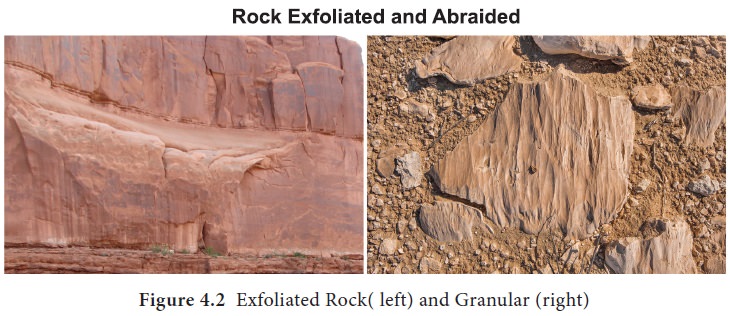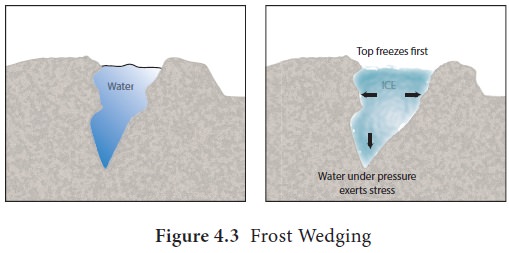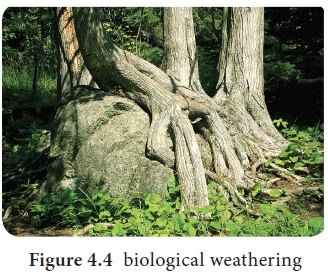Physical, Chemical, Biological Weathering - Weathering | 11th Geography : Chapter 4 : Lithosphere: Exogenic Processes
Chapter: 11th Geography : Chapter 4 : Lithosphere: Exogenic Processes
Weathering
Weathering
Weathering is the process of disintegration and
decomposition of rocks. It is due to the action of climate, plants, animals and
other living organisms which cause the rocks to break down physically,
chemically and biologically.
There are three types of weathering. They are
physical weathering, chemical weathering and biological weathering.
Physical weathering
Physical
Weathering is the disintegration of rock mainly induced by elements of
weather. It produces smaller, angular fragments of the same rock. It is caused
by the change in temperature, pressure, water and wind. Physical weathering is
further divided into different categories. They are thermal weathering, frost
wedging and exfoliation.
1. Thermal weathering
In arid and semi-arid areas, the temperature
increases, heat up and expand the rocks during the day and contract the rock
materials when cooling at night. Under extreme temperature conditions, due to
alternate expansion and contraction, the rocks crack and eventually split. The
thermal weatherings are of two types. They are;
1.
Granular
disintegration and
2.
Block
disintegration
Alternate expansion and contraction of minerals of varying properties in the rocks due to temperature changes, makes the rocks break down into small pieces (Figure 4.2). Due to this, the breakup of rocks occurs, grain by grain. This is known as granular disintegration.

Block
disintegration occurs in rocks such as granite rock. So in the areas
of jointed igneous or layered sedimentary rocks due to the great diurnal range
of temperature, the rocks may break up along the joints and cracks into a large
rectangular shaped blocks.
2. Frost Wedging
Almost all liquids contract when frozen, but when water freezes it becomes larger in size or takes up more space. As water expands it puts great pressure on rocks.
When water enters into the cracks of rocks and freezes, the pressure exerted on the rock
is enough to wedge the walls of the crack farther apart, thus expanding and
deepening the crack. Thus, frost wedging results in weathering of rock.
3. Exfoliation
Rocks generally heat or cool more on the surface
layers. The alternate changes in temperature could cause their outer layers to
peel off from the main mass of the rock in concentric layers just as the skin
of an onion. The process by which curved layers of rock breakaway from the rock
beneath them leaving behind dome shaped monoliths is called exfoliation (Figure
4.2). It is also called as ‘onion weathering’. Exfoliation occurs commonly in
the arid areas.

Chemical Weathering
Chemical weathering is the decomposition of rock.
For example it creates altered rock substances, such as kaolinite (china clay)
from granite. The types of chemical weathering are as follows:
1.
Solution: Some soluble minerals in the rock get dissolved when come in contact with water. Over a
long period minerals get washed away from rock and sometimes leading to the
formation of caves.
2.
Oxidation: When oxygen combines with water and iron, it weakens the rock and breaks it. Example,
rusting of iron.
3.
Hydrolysis: It is the chemical breakdown of a rock substance when combined with water and forms
an insoluble precipitate like clay mineral. The most common example of
hydrolysis is feldspar found in granite changing to clay.
4.
Carbonation: Carbonation is the mixing of water with carbon dioxide to make carbonic acid. This
acid reacts with minerals in the rocks. This type of weathering is important in
the formation of caves.
5.
Hydration: It is the absorption of water into the mineral structure of the rock. Hydration expands
volume and also results in rock deformation. A good example of hydration is the
absorption of water by anhydrite, resulting in the formation of gypsum.
Biological Weathering
Biological weathering is the alteration of rock by
the action of plants, animals, and man. Burrowing and wedging by organisms like
earthworms, termites, rodents, etc., help in exposing the rock surfaces to
chemical changes with the penetration of moisture and air. Human beings by
removing vegetation for agriculture and other activities also help in mixing
and creating new contacts between air, water, and minerals in the rock
materials. Plant roots make a great pressure on the rock materials mechanically
breaking them apart.

Related Topics